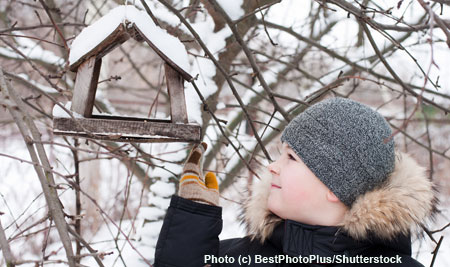|

It's For the Birds
Bird watching is the fastest-growing outdoor activity in North America. And backyard bird feeding is a great way for bird watchers to enjoy seeing birds up-close. If you feed the birds in your yard each winter, you can turn your hobby into research for bird conservation through Project FeederWatch.
Bird populations provide one of the best indicators of environmental health. They are dynamic and change rapidly from place to place and from year to year. Citizen science projects like Project FeederWatch provide data so that bird research and conservation organizations can monitor such long-term changes as species decline and shifts in wintering ranges, track the seasonal movements of irruptive species and chart the spread of illnesses in bird populations.
We've been experiencing dramatic weather changes via climate change, which have been impacting bird populations. For instance, in 2005/06, Canada experienced its warmest winter since modern record-keeping began, with average temperatures 3.9 degrees Celsius above normal. As a result, more northern birdwatchers than ever before were treated to sightings of southern birds like the Red-bellied Woodpecker and the Northern Cardinal.
Kerrie Wilcox, the Canadian coordinator of Project FeederWatch, says that the percentage of feeders visited by Red-bellied Woodpeckers in Ontario, Canada reached an all-time high in that time period, occurring at nearly fifteen percent of feeders. That’s because the Red-bellied Woodpecker’s range has been creeping northward from its core in the mid-Atlantic and southeastern U.S. states over the last decade; it rarely visited more than five percent of sites just five years ago.
In the same way, Northern Cardinals were reported at a whopping seventy-two percent of feeders in Ontario during the same winter. This southern species was almost unheard of in the province a hundred years ago.
Range expansions in southern species such as these could be a signal that changes in climate are making northern regions more hospitable. Likewise, it would be expected that birds located at the southern edge of their range would retract with warmer climatic conditions.
The fate of the Evening Grosbeak is one bird that scientists are trying to understand. Many people who used to see these raucous birds descend on their feeders in large numbers now report that they haven’t spotted one in years. Reports from bird-monitoring volunteers who count the birds at their feeders as part of Project FeederWatch, show that Evening Grosbeaks are, indeed, declining. In fact, Evening Grosbeaks are now completely missing from many areas where they were common as recently as the early 1990s.
Project FeederWatch had its roots in Canada in the mid-1970s. Through the Long Point Bird Observatory on Lake Erie, Ontario, Dr. Erica Dunn established the Ontario Feeder Bird survey in 1976. It is now a winter-long survey of birds that visit feeders at backyards, nature centers, community areas, and other locales across North America and is operated by the Cornell Lab of Ornithology and Bird Studies Canada.
FeederWatchers periodically count the birds they see at their feeders from November through early April and send their counts to Project FeederWatch. FeederWatch data help scientists track broadscale movements of winter bird populations and long-term trends in bird distribution and abundance.
Anyone interested in birds can participate. FeederWatch is conducted by people of all skill levels and backgrounds, including children, families, individuals, classrooms, retired persons, youth groups, Nature centers, and bird clubs. Participants watch their feeders as much or as little as they want over two consecutive days as often as every week (less often is fine). They count birds that appear in their count site because of something that they provided (plantings, food, or water).
New participants are sent a Research Kit with complete instructions for participating, as well as a bird identification poster and more. You provide the feeder(s) and seed. Then each fall participants receive a sixteen-page, year-end report, Winter Bird Highlights and a newsletter.
There is a small annual participation fee, which covers materials, staff support, web design, data analysis, and the year-end report. The project is supported almost entirely by these participation fees.
It's a great way to get your family outside into Nature over the winter, while conducting some Citizen Science.
|

